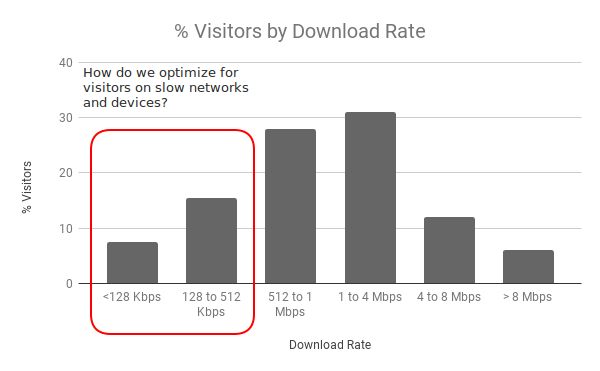Visitors on slower networks & devices : What can we do about them?
Visitors on slower networks & devices : What can we do about them?
Here's a line of conversation that happens frequently when I am talking about Tezify with someone from Conversion Optimization community. Let's call this person Mr. C:
Me : "Your website doesn't load up at the same speed for all your visitors. It may load up blazing fast for some but much slower for others."
Mr. C: "Why would that happen?"
Me: "Because, your visitors access your website from different geo-locations, networks and devices."
Mr. C: "Oh yes. It will load up much slower for someone on a slow network or device."
Me: "Exactly. And it would be interesting to know the kind of networks and devices the slower visitors use."
Mr. C: "But, even if find that, what can we do about it? If a visitor is on a slower network, how can we fix that?"
This is a valid question. Ofcourse, we cannot simply speed up their devices and networks. But, it is a fact that the resulting slowness causes loss of business (bounced visits and missed conversions) for us. So, how can we minimize the loss from slowness in such situations?

To address this, let's talk about focussed speed optimization. Focussed is the key word here. You first identify the key content on your pages that your visitors come looking for. Think Google search bar on Google's homepage. Or, flight search widget on Delta's homepage. Now, you ask your developers to optimize your webpage to show this key content first-up. Before anything else. This is more about getting the sequence of loading your page's content in line with what your visitors want rather than trying to make things run as fast as possible. To get your visitors engaged as early as possible while rest of the page content is loading.
But, how does this help your visitors on slower networks or devices? Well, this kind of optimization ensures that the first bytes that squeeze through your visitor's crawling network carry the most critical parts of the pages. This minimizes the impact of slow network or device on the speed with which the key content of your page shows up. As a result, you minimize the time your visitor has to wait before he is engaged. Let's visualize this with a real-world example.
Here's the page loading sequence for Google's homepage on a fast and a slow 3G network from Lincoln, Nebraska (via www.webpagetest.org):

As you can see, the page is optimized to load up the search bar before the doodle image. If the doodle were to load before the search bar, the search bar would load much later on slower networks (6 seconds on slower network instead of 3 seconds). This would mean visitors would have to wait longer before they could search. And some of those waiting visitors would give up. Loss of conversion.
Infact, this explains how the impact of such optimizations plays out more significantly on slower networks and devices. Such optimizations may not improve our over-all page loading. But with key content showing up in front of our visitors in time, our conversions would definitely see a bump-up. Especially for folks on the slower networks and devices.
So, while we cannot speed up our slower visitors' networks or devices, we can optimize our pages to minimize the time these visitors have to wait. And help our conversions in process.